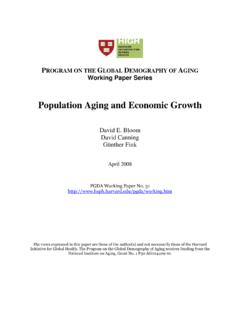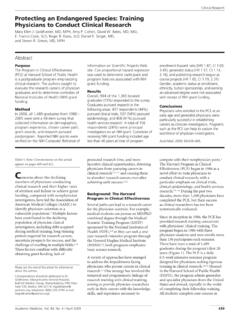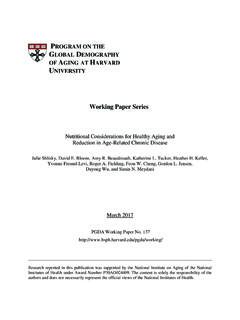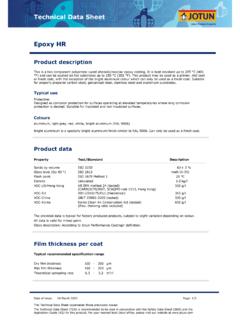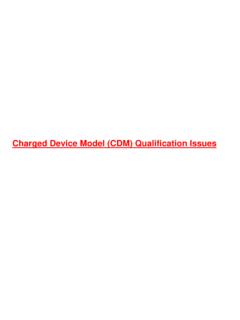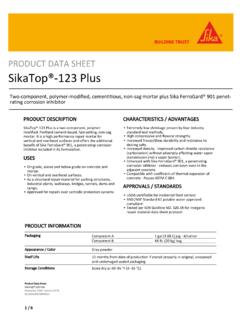Transcription of Techniques for epigenetic analysis
1 Techniques for epigenetic analysisHow to apply them to human and epidemiology Baccarelli, MD, PhD, MPHL aboratory of Environmental Epigenetics Harvard School of Public HealthmicroRNAs(snRNAs)Small non coding RNAs that cause mRNA degradation or impair translation into proteinDNA methylationMethyl marks added to certain DNA bases repress gene activityHistone modificationsA combination of different molecules can attach to the tails of proteins called histones. These alter the activity of the DNA wrapped around them How to detect epigenetic marks?DNA methylation & histonemodification analysis Molecular biology: largely related to genetics methods that analyze the DNA sequence epigenetic marks: do not modify the underlying DNA sequence Workarounds: Bisulfite treatment Antibody based methods (or alternatively methyl binding proteins)Bisulfite treatmentAntibodiesModifies non methylatedcytosinesBind modified or methylated cytosines, modified histonesWorkaroundDNA methylationDifferentiation of methylated and non methylated cytosinesDNA enriched with the mark of interest (Ab specificity)
2 Histone modificationsAnalysisAny method that can analyze sequenceAny method that can quantify enrichment DNA Methylation Gene specific analysis How much methylation at or nearby a candidate gene Global methylation content How much methylation in a test DNA, regardless of the position Genome wide scans Microarrays, Next Generation Sequencing Histone Modifications Gene specific analysis Global modification content Genome wide scansSome Lab NomenclatureBisulfite modification of DNA Prior to PCR, DNA is treated with sodium bisulfite Non methylated C is permanently modified to U In PCR, U and T are equivalentDNA methylation methods DNA Methylation Techniques Gene specific analysis Qualitative Quantitative Global methylation content How much methylation in a test DNA, regardless of the position High coverage methods Genome wide scans, ArraysGene Specific AnalysisWorkflow for DNA methylation analysisby bisulfite pyrosequencingBiospecimenDNA isolationBisulfite treatmentPCR amplificationData analysismethylated C(methylated C) +(unmethylated C) 100%Abbreviations: %5mC, percentage of 5-methylcytosine.
3 C, cytosines%5mC =PyrosequencingPyrosequencingPyrogram84% 76%76%EESSGGTTCCGGTT5 GGTTAAGGTT10 CCTTGGTTCC1502004006008001000A1 : TTC/TGTGGTGC/TGTC/TGPyrosequencing analysis Provides overview of the the methylation pattern Allows for the measurement of the methylation percentage of individual CpG dinucletodes Flexibility in sequencing primer position to analyze any CpG sites you likePyrosequencing & other methods Pyrosequencing Pro: Highly quantitative, single site resolution Cons: dedicated equipment Methylation Specific PCR Pro: inexpensive and easy to perform Cons: qualitative/semiquantitative, no single site resolution Real time PCR Pro: equipment easily accessible Cons: low precision, no single site resolution Maldi TOF (Sequenom Mass Array) Pro: Quantitative, single site resolution, extended sequence (amplicon) Cons: dedicated equipment (high costs), high costs/geneDNA Methylation ContentFigure Genomes 3 ( Garland Science 2007)Global Methylation Most methylation in repeated elements: LINE 1 elements: >500K/haploid genome Alu elements: >1,100K/haploid genome LINE 1/Alu methylation is correlated with global content (Weisenberger, 2005) Function of repeated elements?
4 : Chromosomal structure Repeat sequence transcription miRNAHow to confuse one reader s mind Global DNA methylation Genomic methylation content Genome wide methylation content Genome wide methylation Global cell methylationLower Global Methylation Tissue DNA Cancer (Feinberg & Vogelstein, 1982) Atherosclerotic lesions (Hiltunen, 2002) Blood DNA Cancer (Hsiung, 2007) Cardiovascular Disease (Castro, 2003) Folate deficiency (Choi, 2005) Inflammatory states (Stenvinkel, 2007) Aging (Fuke 2004) Environmental Exposures (Chanda 2005, Bollati 2007, Rusiecki 2008, Baccarelli, 2009) analysis of Global Methylation Content Direct measurement of methyl group content High Performance liquid chromatography (Ehlrich M, et al., Nucl Ac Res 1982) GC/MS (Rossella F et al., Rapid Comm MS 2009) Immunostaining with anti 5mC Digestion with methylation sensitive enzymes (MspI, HpaII) Estimated in repeated elements Based on Pyrosequencing(Yang et al.)
5 Nucl Ac Res 2004) Based on Methylight(Weisenberger et al. Nucl Ac Res 2005)Retrotransposons Transposition: Movement of gene from one chromosome to another or movement from one site to another; does not require homology Transposons: mobile genetic elements that enable genes to move between non similar sites Retrotransposition: Creates genetic diversity Retrotransposons: Replicate and move to other sites on DNA through an RNA intermediateRetrotransposon mRNAR etrotransposon DNAR etrotransposonRNA polymeraseReverse transcriptaseIntegration ProteinOriginal RetrotransposonDuplicated retrotransposonWhat do we measure in repeated elements A few CpG sites in a specific repeated element sequence The sequence (and the CpG sites therein) are repeated throughout one single haploid genome: LINE 1 elements: >500K/haploid genome Alu elements: >1,100K/haploid genome The LINE 1 and Alu assays measure the %mC in those repeated elements, with no distiction about their position in the genome Correlation with global content demonstrated only in studies including cancer tissues A marker of global methylation only for cancer tissues?
6 Genome wide scans Microarrays Illumina Infinium for DNA methylation (bisulfite treatment) 484,000 CpG sites (450K, released in early 2011) $400/samples Nimblegen for DNA methylation or Histone Modifications (Ab based) 2 Million probes >$2000/samples Next Generation sequencing Various platforms Bisulfite treatment (DNA methylation) Ab based (DNA methylation or Histone modifications) $3000/sample for RRBSR egion TypeRegionsCpG sites covered on 450K BeadChip arrayAverage # of CpG sites per regionCpG Island26,153139, Shore 25,77073, Shore 25,61471, Shelf 23,89649, Shelf 23,96848, ,926-Total 485,553 CpG shelves, shores & islands classification (UCSC CpGi annotation)5 UTR3 UTRTSS1500 TSS200N ShelfN ShoreS ShoreS ShelfCpG IslandThe 450K BeadChip covers a total of 77,537 CpG Islands and CpG Shores (N+S)Illumina 450K BeadChip CoverageNGS vs Infinium HM27 Bock et al.
7 , Nat Genet 2010 Infinium: less expensive, most accurate (together with RRBS), easiest for bioinformatic analysisAmmerpohl O et al. Biochim Biophys Acta. 2009 Sep;1790(9):847 : Methylation>25% generated positive resultsHistone Modification analysis Step 1: Histone Purification & Isolation Step 2: Histone Analsyis (Several Methods) ELISA (Enzyme Linked ImmunoSorbent Assay) ChIP (Chromatin ImmunoPrecipitation)Types of measure ELISA Global genomic content of a certain modification: ChIP qPCR Gene specific measure of a certain modification next to a specific gene ChIP on chip Gene specific measure of a certain modification next to many specific gene at the same timeExamples ELISA Histone: H3 Modification: Di Methyl Histone Position: Lys4 (K4) ChIP qPCR Histone: H3 Modification: Di Methyl Histone Position: Lys4 (K4) Gene: p15 ChIP on chip Histone: H3 Modification: Di Methyl Histone Position: Lys4 (K4) Genes.
8 All the genes spotted on the chipChIP qPCRC ells isolated nucleiSonicateImmunoprecipitateReverse crosslinkFormaldeide Cross LinkPurify DNAqPCRChIP on chipHe and Hannon, 2004 MiRNA biogenesis and mechanisms of actionmiRNA analysis Sample collection and processing Same methods as for mRNA Isolation of total RNA Methods Candidate miRNAs: Real Time PCR Microarrays nCounter Nanostring analysis Deep SequencingMicroarrays for miRNA analysisFrom Susan Hester, nCounter Digital counting technology Allows for measuring more than 700 miRNAs Moderate operating costs No need for PCR amplyficationNext Generation SequencingQuestions related to study design Which tissue can I use? How stable are the epigenetic marks within subject over time? Data analysis : Cell type effects ConfoundersHuman Studies: Which Tissue? Target tissues Cancer tissues are easy to obtain They do not necessarily reflect pre disease status FFPE are not easy to work with For some disease we can get at least close Bladder cancer Cells in urine sediments Leukemias White blood cells (benzene effects in Bollati et al Cancer Res 2007)Non Target Tissues How about psychiatric diseases?
9 Embryo layer approach (Neuroectoderma buccal; good only for in utero exposure?) Uniform effects approach: Do exposures modify epigenetic marks in the same way across all tissues? Problem 1: epigenetic marks are tissue specific Problem 2: Distribution of pollutants: different doses in different tissues ( , particulate matter) Highest dose/first target approach Inhalable pollutants nasal mucosa Pollutants in food and water/smoking buccal cellsA Practical Starting Point Existing cohort/studies have collected: Blood/buffy coat Buccal cells Urine Storage Many studies extracted DNA and have no more cells available Questions: Can we use them? Which information can we get?How we have been using WBCs Requirement 1:The gene is expressed in WBCs( ) Requirement 2: The gene has a function in WBCs that is related with: Mechanisms of action of the exposure Disease of interest( ) : Particulate matter iNOS Cardiovascular disease (Tarantini et al.)
10 Environ Health Perspectiv 2009)WBC Methylation in Epidemiology When analyzing data, which are the confounders we need to control for? What do we know about determinants of DNA methylation in human populations? To address this question: Pooled analysis of 1,465 subjects from five investigations In all the investigations: DNA methylation analysis of LINE 1 and AluPooled analysis DataStudy #1 Study #2 Study #3 Study #4 Study #5 All studiesBoston, USAW arsaw, PolandMilan, ItalyBrescia, ItalyTrissino, Italyn=1,465 Alu, 5%mC(SD) ( ) ( ) ( ) ( ) ( ) ( )LINE-1, 5%mC(SD) ( ) ( ) ( ) ( ) ( ) ( )Zhu et al., Int J Epidemiology 2012 Blood Count and MethylationAluLINE-1 Beta*P-value*Beta*P-value*White blood cells, 103 , % , % , % , % , % *Adjusted for age, gender and et al., Int J Epidemiology 2012 Age, gender, alcohola Adjusted for age, gender and and P value for age were obtained using continuous LINE-1 Variable No.





